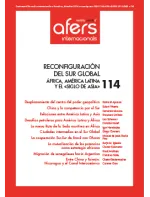Intermediary Cities in the territorial integration of Global South

“Economies of agglomeration” have acted as catalysts of the progress and modernisation of many nations in the Global South but have also contributed to unbalancing the territory, widening the gap between urban and rural populations and the accumulation of high environmental and social deficits. In contrast to the BRICS (Brazil, Russia, India, China and South Africa), the economies that make up the MINTs (Mexico, Indonesia, Nigeria and Turkey) have better territorial integration of their urban systems, with intermediate cities that act as “economies of intermediation” with the rural hinterlands, and which could contribute to achieving the United Nations’ 2030 Agenda for Sustainable Development Goals. The United Nations Habitat iii of October 2016 placed intermediary cities at the heart of the New Urban Agenda. The aim is to promote national urban policies in many of the economies of the Global South, allowing them to strengthen their role as the main instrument of economic integration and regional cohesion.
Key words: intermediary cities, Habitat iii, BRICS, MINT, Global South, territorial integration
>> The full text articles of this issue are available only in Spanish language
https://doi.org/10.24241/rcai.2016.114.3.109